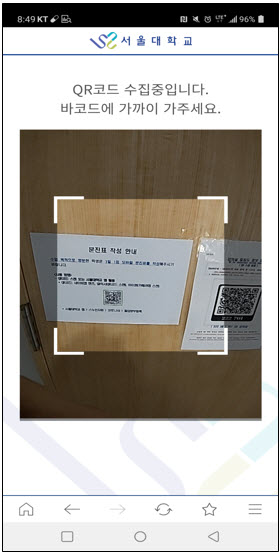Two years have passed since the outbreak of the COVID-19 pandemic, which has put a halt to most offline classes and extracurricular activities. But unlike the previous three semesters, SNU’s Fall 2021 semester was not entirely a semester of serious lockdown, with offline classes resuming from October 18. This was primarily made possible thanks to the university’s thorough disinfection scheme, but there were some other facilitators: the operation of rapid COVID-19 tests inside the campus, QR scanning technology, and prompt epidemiological surveys through a novel smartphone application.
Rapid COVID-19 Tests: Tracking Potential Infections
SNU introduced its own COVID-19 molecule test in April 2021 that informs people of the results more rapidly than general polymerase chain reaction (PCR) tests do. Its supreme advantage is that results can be viewed in no more than two hours after the test, assisting the early detection of newly infected people. This is effective in that the latent period of COVID-19 is up to two weeks, which necessitates a quick testing and quarantine procedure. In particular, professors who conduct offline classes can encourage their enrollees to get tested for any possible infections in the lecture rooms.
Students and faculty members hoping to get tested can head to one of the three test spots at their discretion: the College of Natural Sciences (Building 25-1), the SNU museum (Building 70), or the College of Engineering (*Building 301). All subjects who test positive are reported to the Gwanak public health center, where they must immediately get PCR-tested for more accurate test results. Operation hours of the molecule test sites are from 9:30 AM to 4 PM, with a lunch break from 11:30 AM to 1 PM. Members can access the MySNU application and click the “In-School COVID-19 Test Apply” button to make a reservation for testing.
*Now it changed to the Gwanak Residence Halls (Building 906) from December
QR Scanning Services for Contact Tracing and Informing Population Density
If you have ever visited a lecture room or a cafeteria at SNU this semester, you will have noticed a QR code in front of the door or on the wall. This QR code serves two main purposes to assist offline classes. The first is for contact tracing. Starting this Fall semester, students coming to school to take offline lectures should click the “QR Scan” button on the MySNU application and scan the QR code in the building, which informs the university when and which building they visited. If an infection case occurs, SNU will use this information for epidemiological investigations.

The second purpose is to indicate the campus population density in real-time. By clicking the “Density” button on the MySNU application, members can check how crowded a certain building or lecture room is. The application shows the density through color. If the color is red, it means that the density is more than 50 percent its capacity. Yellow indicates 30 to 50 percent density, and green shows density of less than 30 percent. For lecture rooms, the lecture schedule is provided as well, enabling students to easily find less crowded spaces when they visit the campus.
A New Application: COVID Human Traffic Information
Professor Cheon Jung Hee (Department of Mathematical Sciences) and his research team has recently created a smartphone application to allow school members to freely check if their routes overlap those of any confirmed cases. The service is currently available in the Seoul Metropolitan Area, and the operators are planning to extend the service area. This application uses the newly developed homomorphic encryption technology, lessening the possibility of any personal information leakage. It can be downloaded through either the Google Play Store or the iOS App Store applications.
Thanks to SNU’s efforts to quickly track confirmed cases and update the population density inside campus, SNU is returning to normal, step by step.
Sources: https://www.snu.ac.kr/snunow/snu_story?md=v&bbsidx=134135, https://www.snu.ac.kr/snunow/snu_story?md=v&bbsidx=132195
Written by Seunghwan Oh, SNU English Editor, ascendhwan@snu.ac.kr
Reviewed by Professor Travis Smith, Department of Asian Languages and Civilizations, tlsmith@snu.ac.kr

